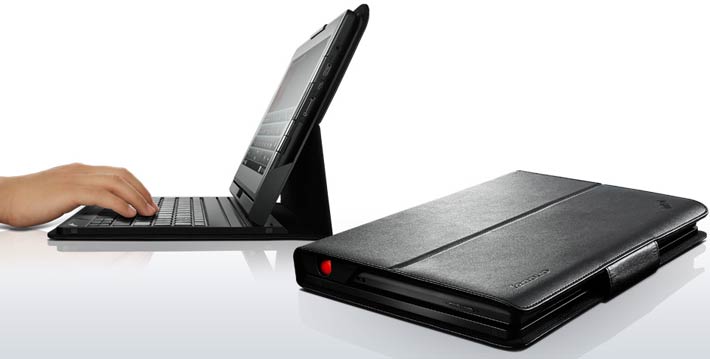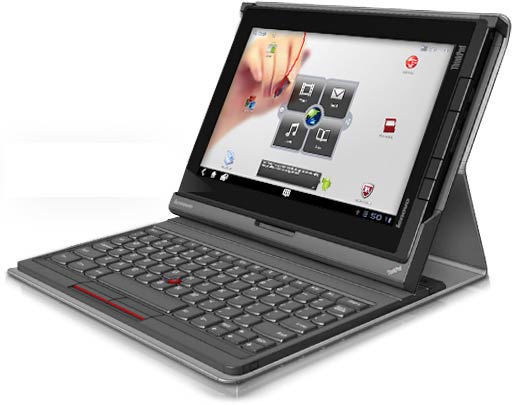
Our proud sponsors:












|
|
|
|
|
|
Lenovo ThinkPad TabletSuperior keyboard and case differentiate this tablet, but it's heavy and Android may not be ready for businessby Daniel Rasmus
There are many Android tablets, and as Android tablets go, software isn't the differentiating factor. In the case of the Lenovo ThinkPad Table, the beefy, somewhat awkward device isn't the reason you'll want to buy one either. The reason to buy a ThinkPad Tablet is its $100 keyboard and case. This Android incarnation of the iconic ThinkPad sports a killer keyboard. It is beautifully sculpted, holds the ThinkPad tightly, adjusts to different angles, and creates a responsive cursor with its optical nub placed unobtrusively in the middle of the keyboard.
But this is a tablet review, not an accessory review (though I'm not done commenting the portfolio keyboard—more later).
Standard ports include headphones, mini-HDMI, USB and microUSB, along with a full size SD card. And not only does it have ports, but even the protected ones are pretty accessible, though the combination of flip and sliding covers does make it look a little like a Transformer. The ThinkPad charges through the microUSB port, which doesn't require flipping or sliding a cover. It would be nice if all tablets used this (or some) standard port. Kudos to Lenovo for keeping cable clutter to a minimum.
Although the ThinkPad Tablet does feel heavy, it feels balanced when switching between portrait and landscape orientations. The well-designed exterior combines a rubberized back with a Gorilla-glass display exudes quality, which isn't the case with lesser tablets. But the 10.3 x 7.2 x 0.6 inches design is, and feels, thicker and more awkward than the Galaxy Tab or iPad 2.
Like the HTC Flyer, the ThinkPad also comes with a pen, which should offer much greater cursor control. In practice, however, the handoff between the pen, which disables touch input once recognized, doesn't kick in fast enough, so using the pen doesn't always deliver the expected results. I tend not to draw with the pad of my hand and I don't like the awkward, non-interference approach to pen computing where the pen protrudes from a clutch of puckered fingers hovering in strained weightlessness just above the tablet's waiting display.
My least favorite feature of Think Pad comes in the form of buttons on one edge. When holding the Think Pad with my right hand, I often subject the device to unintended commands, like going to the home screen or disable rotation. Android is designed for button-less devices, and that's how they should come.
The 2-megapixel front facing, and 5-megapixel rear facing cameras are adequate for most uses, including lightweight video conferencing. Other sensors include an accelerometer, a gyroscope, assisted GPS and an ambient light sensor. All expected, all functional.
Perhaps the most unique of the ThinkPad Tablet applications comes in the form of MyScript Notes Mobile. The Notes application offers solid note taking and annotation features, including the mark-up of PDF documents. Unfortunately the Notes application works in portrait mode only, ignoring landscape reorientation. On a tablet, most applications, especially general, horizontal applications, should work the way the user wants to work. On the practical level, this means the Notes app is only good in full tablet mode. Given that the keyboard forces horizontal orientation, the app is useless when typing. That aside, the Notes application's solid handwriting recognition make it a good inclusion, but given the architecture of Android, I would expect Google to offer note taking and PDF annotation as standard features in future versions of the OS.
Two things I don't like about the keyboard. First, it is a USB keyboard which means when the keyboard is attached the USB port isn't available. That may draw less power than Bluetooth, but it incapacitates some of the Tablet's features. The other issue is the tab at the top of the case that hold the tablet in place. Even with the finger lift slot at the bottom of the bezel that holds the tablet, removing the tablet from the case doesn't have a good feel to it. I'm always worried I'm unduly wearing a component, or bending the USB connector (which doesn't seem to have happened, it just feels like it may, each time I remove the device). And even though you can flip the case over and reverse its magnetic flap to attach to the back of the case to keep it out of the way, keeping the case on in tablet mode greatly increases bulk-weight-clumsy factor to an untenable level. The Lenovo Keyboard Portfolio adds over 1.4 pounds to the package, taking the total weight to over 2.7 pounds. An equivalent-sized MacBook Air, by comparison, runs only 2.38 pounds. The case also blocks access to the SD slot, but leaves the other ports accessible.
Other accessories include a docking station and various cases, mobile power connections and replacements for easily lost or damaged items, like the pen.
On the software side, the minimal skinning doesn't add much to the Android Honeycomb implementation on the ThinkPad—and the preloaded software confuses. The marketing is clear—it is a business device, and that means all the games and entertainment software are even more confusing. That confusion, however, isn't limited to the Lenovo ThinkPad Tablet. The Android market remains confused and this device simply reflects that muddle.
Lenovo needs to learn from this first foray into Android for business and pay more attention to the competition. There are many tablets in the market, and unless a manufacturer offers clear competitive differentiation along with meeting all of the existing expectations, the device will likely remain an also ran. For the ThinkPad Tablet, its brand and keyboard accessory may be enough to entice long-time ThinkPad aficionados, but I think those buyers might do better with Lenovo's convertible ThinkPad X series notebook computing than with the stripped down capabilities of an Android tablet. If you are really looking for a business machine, then buy a real business machine. At this point, Android just doesn't offer a compelling story, even when teamed with a leader in business laptops.
Daniel W. Rasmus is an independent analyst and strategy consultant. He is a former Vice President at the Giga Information Group and Forrester Research. Dan is the author of five books, including Management by Design (Wiley, 2010) and Listening to the Future (Wiley 2008). He blogs regularly at http://danielwrasmus.wordpress.com. Additional information can be found at http://danielwrasmus.com.
|

 If Android is a business requirement, and entering data, through writing or keyboard, is part of the use case, then the Lenovo ThinkPad tablet is worth a look. As a general tablet, any machine that is heavier or clumsier than the Galaxy Tab has to really justify its extra ounceage with meaningful features like SmartCard readers or extended battery life. The ThinkPad Tablet doesn't have a SmartCard reader and its battery life is on par with other tablets. The device's bevy of ports and integrated pen may justify a thicker profile, but they doesn't justify the weight. If you are looking for a general Android tablet, better engineered machines may be hard to find, but better designed machines exist.
If Android is a business requirement, and entering data, through writing or keyboard, is part of the use case, then the Lenovo ThinkPad tablet is worth a look. As a general tablet, any machine that is heavier or clumsier than the Galaxy Tab has to really justify its extra ounceage with meaningful features like SmartCard readers or extended battery life. The ThinkPad Tablet doesn't have a SmartCard reader and its battery life is on par with other tablets. The device's bevy of ports and integrated pen may justify a thicker profile, but they doesn't justify the weight. If you are looking for a general Android tablet, better engineered machines may be hard to find, but better designed machines exist.